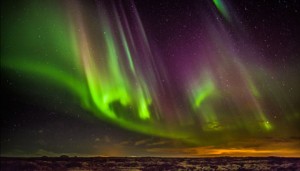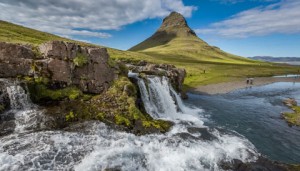
iceland.is
I’ll never forget when I saw the Northern Lights for the first time. I was driving north through southern Maine long after dark, and through the windshield I noticed something strange about the sky. There were thin white clouds, but they were moving. They rippled, billowed, and surged. On a quiet stretch of road, I pulled over and got out. By then I’d realized what I was seeing, and I stood there for quite awhile, neck craned, mouth agape, awestruck.
Over the years I’ve been to many high-latitude regions — Alaska, Baffin Island, Greenland, the Antarctic Peninsula. But it’s always been in the summertime, when daylight rules even at night, and I’ve never again seen auroras, much less in color. Which is why I’m very excited to help lead S&T’s third-annual aurora trip to Iceland this October. Want to join us?
Besides getting a fascinating tour of Iceland during the day arranged by Spears Travel, we will have multiple opportunities to witness some amazing auroral displays at night. Auroras occur within an oval up to 900 miles wide that is centered on the Earth’s geomagnetic poles, and Iceland always lies within or near this ever-shifting oval.

iceland.is
Strong auroras happen more frequently around the equinoxes, making October a great time to head outside in late evening — not to mention it actually gets dark in Iceland at that time of year. And we’ve scheduled the trip for a time when the Moon won’t interfere too much with our viewing. Finally, the years on either side of a solar maximum — the time of greatest solar activity in the Sun’s typically 11-year cycle — often result in the finest auroras, and, according to NASA, solar max was reached in 2014.
What is the aurora? Galileo was the first to call this otherworldly phenomenon the aurora borealis, or “dawn of the North.” (The Southern Hemisphere’s version is the aurora australis.) The lights form when charged particles shot out from the Sun breach our planet’s magnetic field and collide with and ionize gas high in our atmosphere. We’re talking really high: typically between 50 and 185 miles up, far above any weather phenomena. Impacts with oxygen atoms result in green and bright red colors, while those with nitrogen molecules produce blues and deep reds.
If you’re interested in photography, you’ll be happy to know that on our trip we’ll have along a very skilled photographer of the night sky — Sean Walker, S&T’s long-time Imaging Editor and now Equipment Editor. Sean will be on hand to help you take the best photos you can of any auroral displays we see.
During the day we’ll visit some iconic natural and cultural features of Iceland. See the itinerary for complete details.
Hope to see you in Reykjavík this fall!
 4
4
Comments
March 12, 2015 at 11:39 am
That is amazing. I wish i could go to iceland but i am only 13 years old so i can't
You must be logged in to post a comment.
March 14, 2015 at 10:18 am
Jamez, I met Neil deGrasse Tyson on an eclipse cruise in 1972 and he was 13 years old. I was 19. Don't say can't. You can do it if you save your money and go with a reputable tour company. Good luck.
You must be logged in to post a comment.
Graham-Wolf
March 17, 2015 at 12:44 am
For us in the Antipodes, NZ is an excellent place to see the counterpart.... the Southern Lights or AURORAE AUSTRALIS. Have been originally born and raised in Dunedin (Lat 46 deg South) I can guarantee an excellent show if you ever visit there during a geo-magnetic storm. Invercargill (Lat 48 South), shows the Auroral displays almost directly overhead.
The Royal Astronomical Society of NZ (RASNZ) still has an Aurora and Solar Section. Observations are regularly sent off to the BAA, by this group.
With a simple Compact Digicamera on a tripod.... set your ISO to 400, 800, 1600.
Use the settings programme... set to NIGHT SKY (if you can)
Set your shutter delay to 2s... to avoid camera shake.
Set your lens wide open... say f2.8, 3.5 or whatever it will fully open to.
Bracket shots at 5s, 10s, 15s at the widest magnification setting... say 28mm, or 35mm to avoid star smearing from the Earth's rotation..
I use a simple 10Mpx Canon A480 at 37mm efl, f3.0, and 400 or 800 ISO from Lower Hutt, NZ.
The Southern Coastline looking across Cook Strait.... say from Baring Head or Turakirae Heads are two favourite local haunts of mine. The Northern and Southern lights tend to "fire up" at the very same time... from nearly 50 years of personal experience.
Good luck and best wishes for the "Northern" Aurora Expedition.
Looking forward to seeing YOUR photos!
Clear skies
Graham W. Wolf
Lower Hutt, New Zealand
You must be logged in to post a comment.
Graham-Wolf
March 19, 2015 at 12:49 am
If you can't make it to Iceland, there are other locations where you can get a good but not so great view of the Aurora Borealis.
These include Scotland, Alaska, Siberia!, Northern Canada. I've even heard of some success from Northern Mongolia. The views from Scandinavia (of course) are quite amazing!
Here in NZ, we're having 3 or 4 consecutive days of strong Auroral activity (Aurora Australis). Best seen from the lower South Island (Lats 45 to 48 South). However today, managed a quick peek ~ 5am NZDT and saw rays IBC2 to the SW, from Lower Hutt, near Wellington (Lat 41 South). This was whilst observing Nova Sag 20125 No 2, with Binocs, from my back yard.
As they say... "If you don't get off the couch and step outside for a look, then don't expect to see anything".
Good luck!
Graham W. Wolf:- Lower Hutt, New Zealand.
You must be logged in to post a comment.
You must be logged in to post a comment.